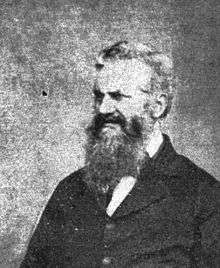Andrew Scott Waugh

Major General Sir Andrew Scott Waugh (3 February 1810 – 21 February 1878) was a British army officer and surveyor now remembered as the man who named the highest mountain in the world after Sir George Everest, his predecessor in the post of Surveyor-General of India.
Early life
Waugh was born in 1810 and joined the Bengal Engineers.
Career
Waugh began work on the Great Trigonometric Survey of India as a young officer in 1832, two years after Everest had been appointed Surveyor-General. When Everest retired in 1843, Waugh replaced him as Surveyor-General and continued his work from the area he had reached, the Himalayas.
The great height of this area, however, combined with its unpredictable weather, meant that few useful sightings were obtained before 1847. In an era before the electronic computer, it then took many months for a team of humans to calculate, analyze and extrapolate the trigonometry involved. According to accounts of the time,[1][2][3] it was 1852 when the team's leader Radhanath Sikdar came to Waugh to announce that what had been labeled as "Peak XV" was the highest point in the region and most likely in the world. None of the observers involved had suggested the peak might be the highest, although this is understandable as each of the six separate points from which it had been sighted were at least 100 miles (160 kilometres) distant.
In case of error, Waugh did not publish this result until 1856, when he also proposed that the peak be named Mount Everest in honor of his predecessor.[4] This was (and has since been) controversial, as Everest had always used local names for the features he surveyed, a practice Waugh had continued. Waugh claimed, however, that no local name for the mountain could be ascertained[5] and he was unaware of its Tibetan name, Chomolungma ("Goddess Mother of the World"). Ironically, though Everest himself was one of those who objected at the time,[6] the name "Mount Everest" was officially adopted a few years later.
The height of Mount Everest was calculated to be exactly 29,000 ft (8,839.2 m) high, but was publicly declared to be 29,002 ft (8,839.8 m) in order to avoid the impression that an exact height of 29,000 feet (8,839.2 m) was nothing more than a rounded estimate.[7] Waugh is therefore wittily credited with being "the first person to put two feet on top of Mount Everest".
Plaudits followed soon after Waugh's identification of Mount Everest. In 1857, the Royal Geographic Society awarded him its Patron's Medal and the following year he was made a Fellow of the Royal Society. Three years later, in 1861, he attained the rank of Major General and was replaced as Surveyor-general by Henry Thuillier.
Later life
Waugh died in 1878 and is buried in Brompton Cemetery midway along the eastern wall.[8]
Personal life
His first wife, Lady Waugh, died 22 February 1866, aged 42.
His second wife was Cecilia Eliza Adelaide, who died 9 February 1884.
Footnotes
- ↑ Ram Copal Sanyal, ed. (1894), Reminiscences and anecdotes of great men of India: both official and non-official for the last one hundred years, p. 25
- ↑ See report in 'The Illustrated London News', 15 August 1857
- ↑ Biswas, Soutik (20 October 2003). "The man who 'discovered' Everest". BBC News. Retrieved 9 August 2016.
- ↑ Letter to the Asiatic Society of Bengal. Waugh originally proposed the French-sounding "Mont Everest", but quickly amended it.
- ↑ Waugh 1857, quoted in Keay 2000.
- ↑ Notice appended to Waugh 1857.
- ↑ Letters to the Editor, The American Statistician, Vol. 36, No. 1 (Feb. 1982), pp. 64–67 JSTOR
- ↑ Sir Andrew Scott Waugh, findagrave.com.
Bibliography
- John Keay, The Great Arc: The Dramatic Tale of How India was Mapped and Everest was Named, HarperCollins Publishers: New York, 2000 (ISBN 0-00-257062-9).
- Andrew Scott Waugh:
- "Papers relating to the Himalaya and Mount Everest", Proceedings of the Royal Geographical Society of London, no.IX pp. 345–351, April–May 1857.
- "Mounts Everest and Deodanga", Proceedings of the Royal Geographical Society of London, vol.2, 1858, featuring the first printed map to identify Peak XV as "Mount Everest".
- Instructions for Topographical Surveying, Roorkee: Thomason College Press, 1861 (LoC ctrl# 05033399).